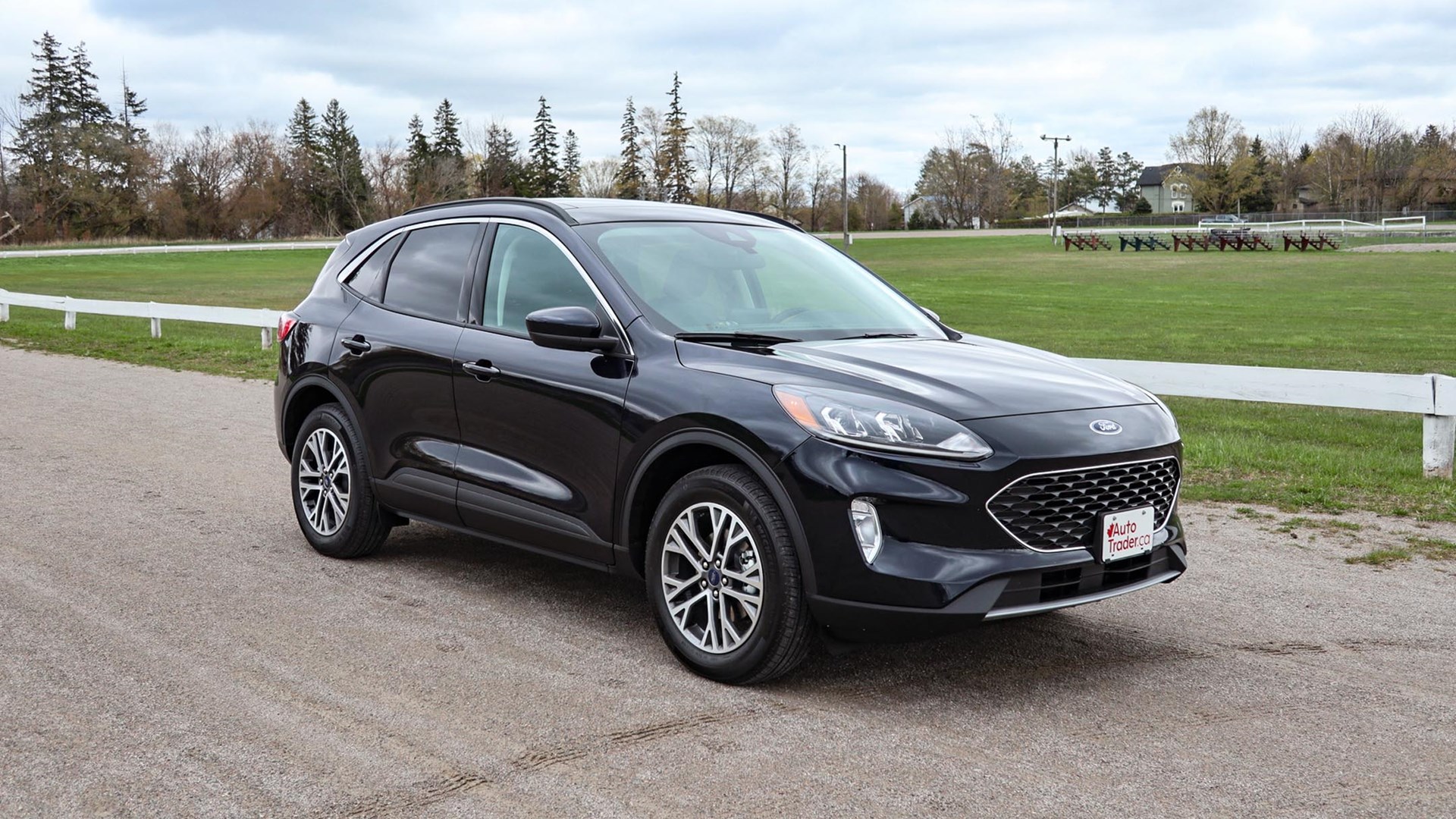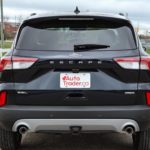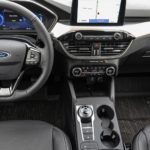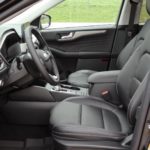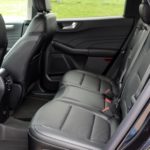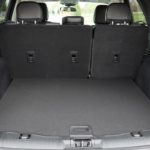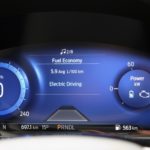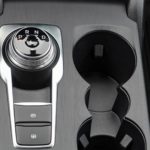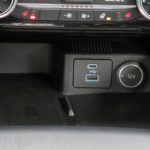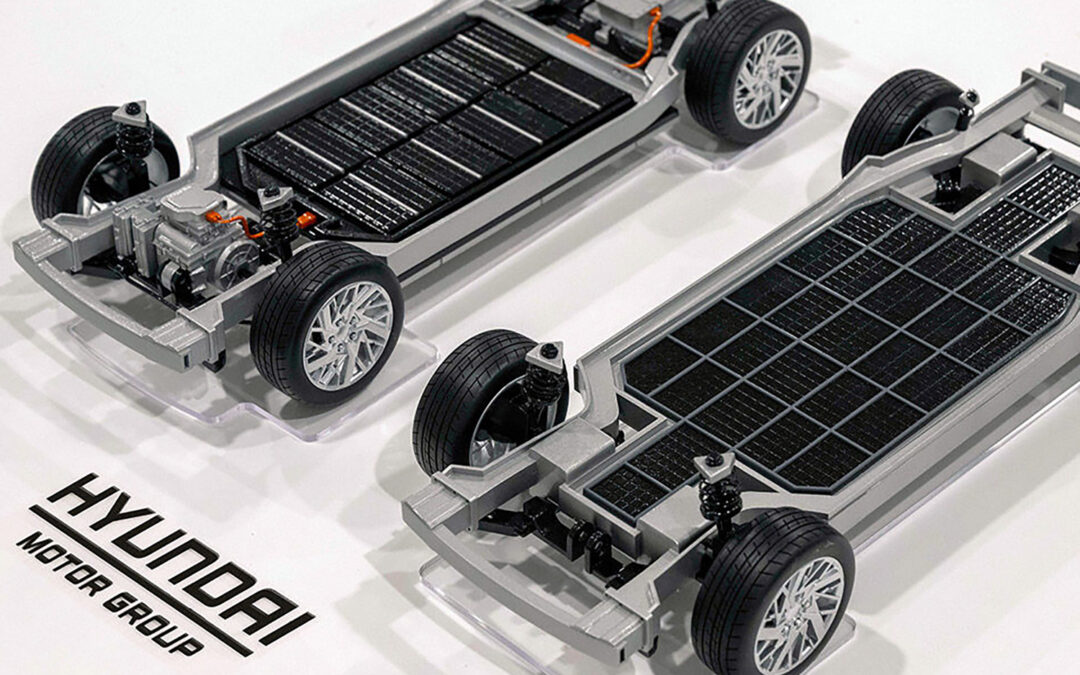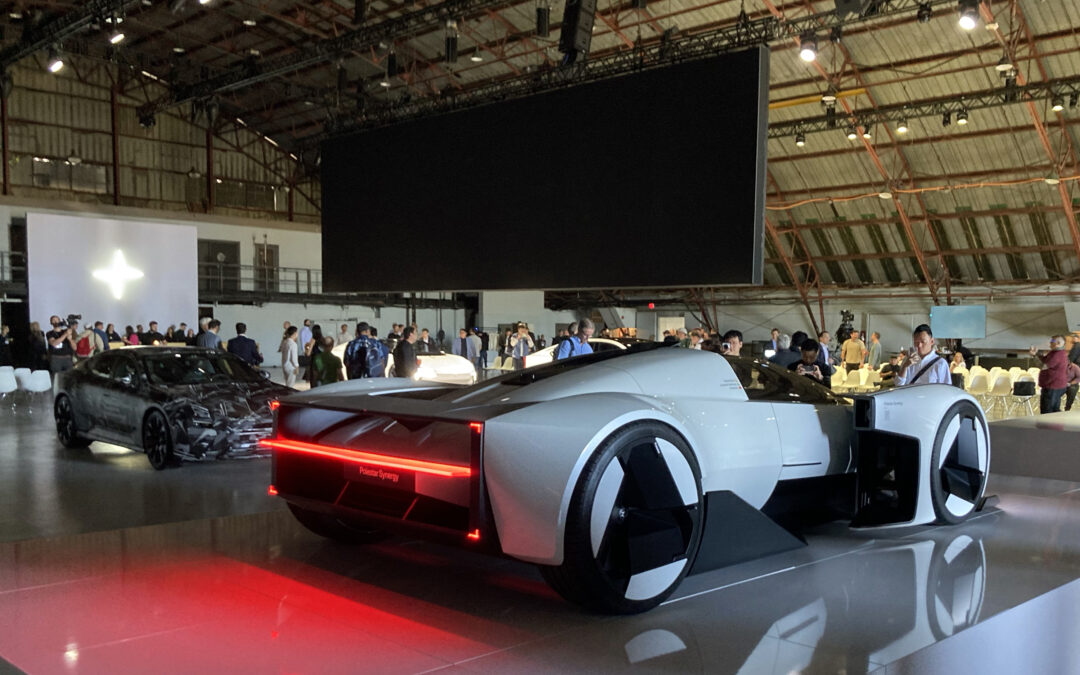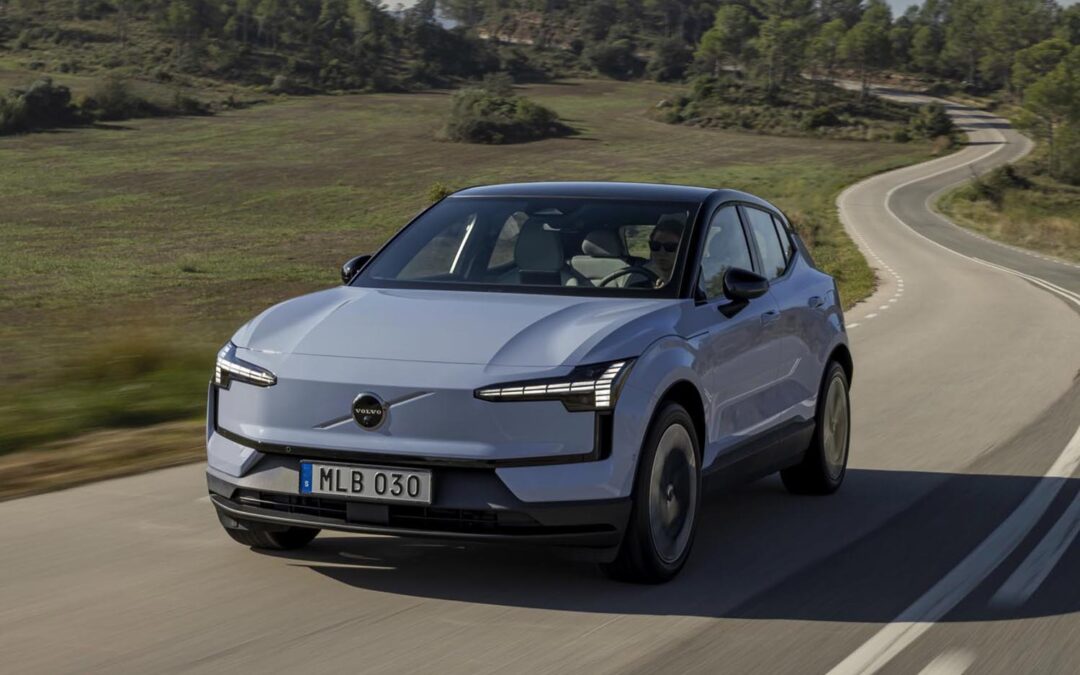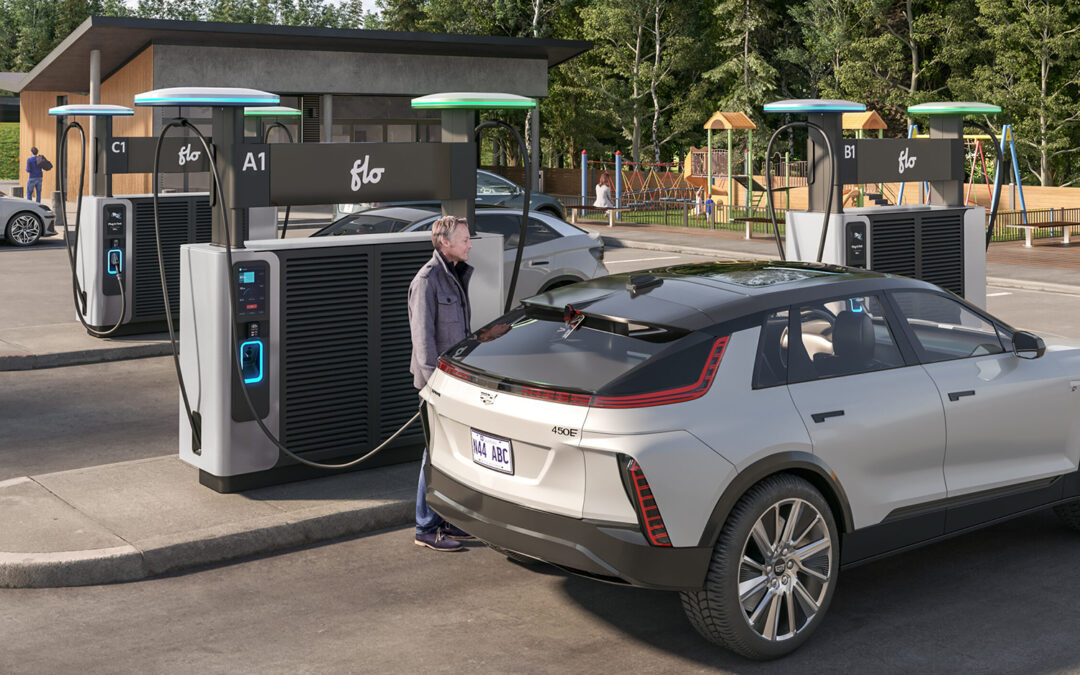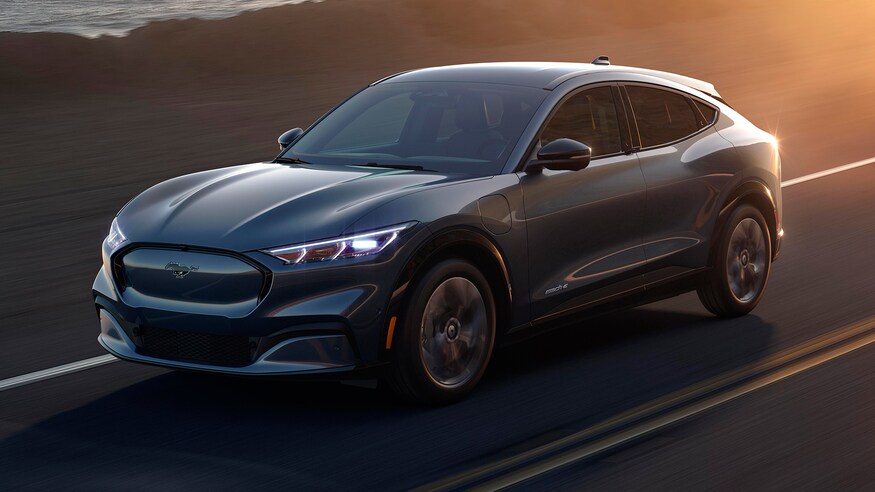Ford introduced its first Escape Hybrid for 2005, marking the world’s first hybrid SUV.
It disappeared seven years later, but the automaker brought back the hybrid powertrain as part of the Escape’s 2020 redesign. The 2021 Ford Escape Hybrid comes in three trim levels, from the SE to Titanium. The mid-range SEL tested starts at $35,249 before freight and taxes in front-wheel drive, and increases to $36,749 for all-wheel drive. My tester also had a considerable number of options stuffed into it, bringing it to $42,699 before freight and taxes.
Styling: 8/10
Overall, the Escape is a good-looking vehicle; it’s a bit plain from the front, but far more interesting from the rear with its sculpted tailgate and wraparound taillights. I especially like the chrome strip that runs over the windows, which adds interest without going over the top – especially on my tester’s Antimatter Blue, a new paint shade for 2021.
The SEL comes with handsome 18-inch wheels (the SE gets 17-inch wheels; the Titanium 19-inch units) and includes a standard power tailgate that was hands-free on mine, thanks to a $2,500 Technology package that additionally included an upgraded stereo and other interior features. I also had a panoramic sunroof that added $1,750 to the tab.
Safety: 9/10
The United States National Highway Traffic Safety Administration (NHTSA) gives the Escape Hybrid its highest rating of five stars, while the Insurance Institute for Highway Safety (IIHS) names it a Top Safety Pick. Emergency front braking, blind-spot monitoring, and lane-keeping assist are standard on all trim levels. My tester was further optioned with an $850 suite that added adaptive cruise control with stop-and-go; lane-centring; speed sign recognition; evasive steering assist, in case you’re trying to avoid a collision and you don’t turn the wheel hard enough; and navigation.
- 2021 Ford Escape Hybrid
- 2021 Ford Escape Hybrid
- 2021 Ford Escape Hybrid
- 2021 Ford Escape Hybrid
Features: 8/10
All hybrid models come with dual-zone automatic climate control, automatic headlights, push-button start, Apple CarPlay and Android Auto, Wi-Fi hotspot, and heated front seats. My mid-range SEL tester added a heated steering wheel, one-touch up/down on all windows, remote starter, a 10-way power driver’s seat, heated mirrors, roof rails, and foglights.
But there’s always room for add-ons, and my tester had a few of them. The priciest was that Technology pack at $2,500, which added such items as an upgraded stereo, kick sensor for the tailgate, power driver’s seat, and wireless charging. I also had a panoramic sunroof for $1,750 – not being a fan of glass tops, I’d save myself some cash there – and a Class II towing package for $600, although capacity maxes out at 680 kg (1,499 lb).
User Friendliness: 8/10
It seems to be trendy on an electrified vehicle to put many functions within a big screen, where access can range from irritating to dangerously distracting, but for the most part, the Escape is refreshingly simple. The climate functions are buttons and dials, and while I’d prefer a dial to the tap-up-tap-down toggles for the fan speed, everything else is easy enough that I’ll forgive it. The heated seats and steering wheel are handled by hard buttons, too.
The infotainment system uses an infotainment system that’s not quite the top dog – the one developed by Fiat Chrysler Automobiles (FCA) is still my gold standard – but it’s been streamlined and simplified over the years, and it’s easy to use. Tapping “Controls” brings up the menus, and from there, you are taken to intuitive pages. I spoke my navigation destination and the address immediately came up; and I really like that you can turn the voice directions on or off by tapping an icon on the map. Many other systems require you to page deep into the menus to do so.
Practicality: 7.5/10
The Escape’s wide hatch and relatively low liftover make it easy to load. But while its cargo capacity ranges from 869 to 974 L with the rear seats up, and 1,852 L with them folded, its arch-rival Toyota RAV4 Hybrid offers 1,059 L with the seats up, and 1,977 L with them down. For those who take their toys to the cottage, the Toyota can also tow up to 794 kg (1,750 lb) to the Ford’s 680 kg (1,499 lb).
The rear seats don’t fold all-the-way-flat, but they’re easy to operate. Up front, the Escape offers good small-item storage, with a covered console box, and an open cubby with removable rubber liner for easy cleaning. In the SEL and Titanium, you get a total of eight cupholders to keep everyone well above the necessary hydration level.
- 2021 Ford Escape Hybrid
- 2021 Ford Escape Hybrid
- 2021 Ford Escape Hybrid
- 2021 Ford Escape Hybrid
- 2021 Ford Escape Hybrid
- 2021 Ford Escape Hybrid
- 2021 Ford Escape Hybrid
Comfort: 8/10
While the SE has cloth seats, my SEL and the upper-level Titanium are clad in an easy-clean, leather-like material that looks and feels good. Heated seats and steering wheel are standard in the SEL, and the chairs are comfortable and fairly supportive. Rear seat room is good, as is the headroom.
But while my 10-way power driver’s seat let me find the perfect position, I was far less happy when I swapped over to the passenger side. That one’s strictly four-way manual, and while that isn’t bad in itself, I found it set too high. Though I’m not all that tall, and I felt uncomfortably perched up on top of it, and I can only imagine how a tall passenger would feel. You’ll have to sit in it yourself to see how you do, but I wanted some way to lower the seat height, and that’s not possible. My tester was optioned with a memory setting for the driver’s seat and mirrors, but a power passenger seat comes only in the top-level Titanium trim.
Power: 8.5/10
The Escape Hybrid is powered by a 2.5L four-cylinder engine that, on its own, makes 165 hp and 155 lb-ft of torque. It’s mated to the hybrid system’s electric motor, and when they work together you get a combined 200 hp. That’s less than in the Toyota RAV4 Hybrid, which makes a combined 219 hp, but the Escape weighs slightly less, and I never felt wanting for a stronger engine.
The system can drive on gasoline, electricity, or a combination of both, and it automatically and seamlessly switches between them, depending on what’s best for the driving conditions. A plug-in hybrid (PHEV) is also available, which will run on electricity alone after it’s charged, and then revert to gas – electric hybrid operation when the charge runs out.
Power goes to the wheels through an automatic continuously variable transmission (CVT). The all-wheel drive system, optional on the SE and SEL, and standard on the Titanium, disengages the rear wheels under most driving conditions for fuel economy, and almost instantly hooks them back up when needed for traction. Many of these on-demand systems send a maximum of 50 per cent of available torque to the back, but Ford says the Escape can deliver all of what’s available to the rear wheels if it’s needed to keep you going.
Driving Feel: 8.5/10
The Escape Hybrid is a pleasure to drive, whether you’re taking it through tight traffic or hauling up the highway. The steering is smooth and responsive, and the ride is supple enough to be comfortable without being too soft. There’s a very tight turning circle, too, and it’s easy to manoeuvre and park this nicely-sized vehicle.
Almost everything is just-right, save for an artificial feel to the brakes. It’s certainly not make-or-break-it bad, but you’ll have to get used to them, and some other hybrids have much more of a “regular” feel to them. As with all hybrids, the Escape uses regenerative braking to charge its hybrid battery, capturing the kinetic energy otherwise lost during braking and converting it into electricity.
Fuel Economy: 9/10
The all-wheel-drive Escape Hybrid is rated by Natural Resources Canada (NRCan) at 5.5 L/100 km in the city; 6.4 on the highway; and 5.9 in combined driving. The all-wheel drive system doesn’t present much of a penalty, as the front-wheel-only model is only a fraction off, at 5.4/6.3/5.8 L/100 km city/highway/combined.
In combined driving, I averaged 6.1 L/100 km, and 87-octane fuel is all that’s needed. The Escape is neck-and-neck with its RAV4 Hybrid competition, which comes only in all-wheel, and which is officially rated at a combined 6.0, to the Escape’s 5.9 L/100 km.
Value: 7/10
The Escape Hybrid starts at $32,749 for the SE front-wheel-drive trim, while my SEL AWD began at $36,749 and was topped up to $42,699. There was a fair bit in my vehicle for that, plus a lot of driveline technology, but while the Escape’s cabin is comfortable and well-designed, there’s a lot of pebbly plastic and it didn’t feel quite up to a $40,000-plus sticker.
I still might have given it a higher rating, except that Toyota has a better value proposition with its RAV4 Hybrid, which starts at $32,590. All-wheel drive is standard on the RAV4, which is just $201 more than the base Escape, where Ford’s AWD is an additional $1,299 – and then the base Toyota also gives you heated mirrors and adaptive cruise control, which are extra-charge add-ons to the base Ford. Comparing my SEL tester with its load of options, the RAV4 XSE is very closely-equipped without any add-ons, and it’s $529 less than my Escape.
The Verdict
That price point alone will send many people to the Toyota store when they’re looking for a compact hybrid sport-ute. Hyundai also has a 2022 Tucson Hybrid, and there are models like the Mitsubishi Outlander plug-in hybrid (PHEV) and the smaller Kia Niro, giving you much more choice than in the past. But the Escape Hybrid is a comfortable, great-to-drive fuel-sipper, and don’t forget to test drive it as well when you’re shopping for your hybrid ride.
Competitors
- Hyundai Tucson Hybrid
- Mitsubishi Outlander PHEV
- Toyota RAV4
Specifications
| Engine Displacement | 2.5L | Model Tested | 2021 Ford Escape SEL AWD Hybrid | |
|---|---|---|---|---|
| Engine Cylinders | I4 | Base Price | $36,749 | |
| Peak Horsepower | 165 hp @ 6,250 rpm (gas engine only), 200 hp (hybrid net) | A/C Tax | $100 | |
| Peak Torque | 155 lb-ft @ 4,500 rpm | Destination Fee | $1,900 | |
| Fuel Economy | 5.5 / 6.4 / 5.9 L/100 km cty/hwy/cmb | Price as Tested | $44,699 | |
| Cargo Space | 869–975 L seats up; 1,852 L seats down | |||
| Optional Equipment | $5,950 – Panoramic sunroof, $1,750; Floor liners, $250; Class II towing package, $600; Ford Co-Pilot360 Assist+ with adaptive cruise control, lane centring, speed sign recognition, evasive steering assist, voice-activated navigation, and Sirius XM Traffic and Travel Link, $850; SEL Technology Package of B&O 10-speaker sound system, hands-free liftgate, 12.3-inch digital instrument cluster screen, memory package, and wireless charging pad, $2,500 | |||
This article was originally published on AutoTrader.ca
